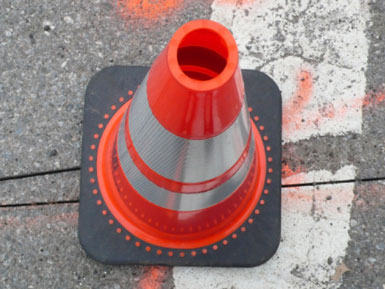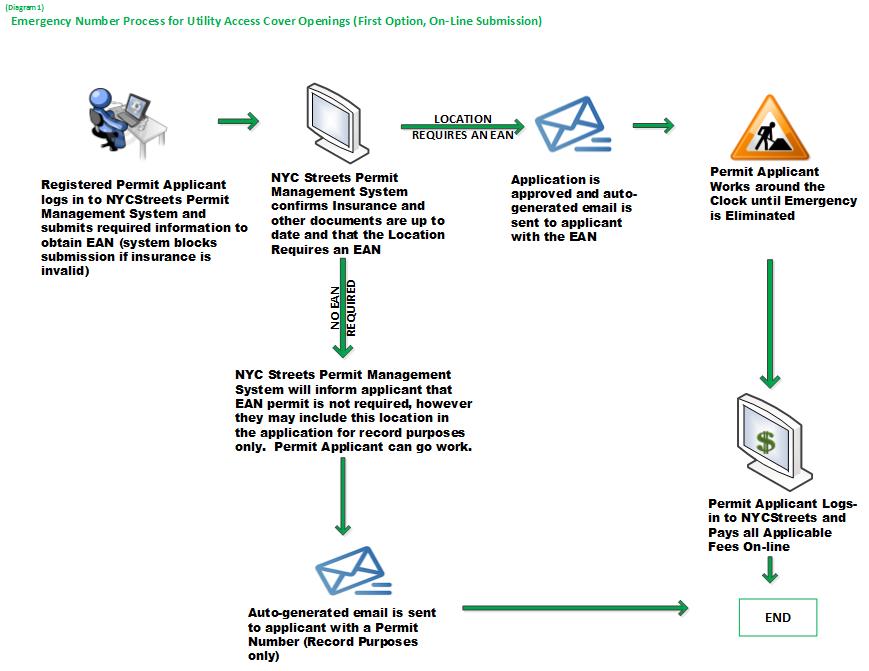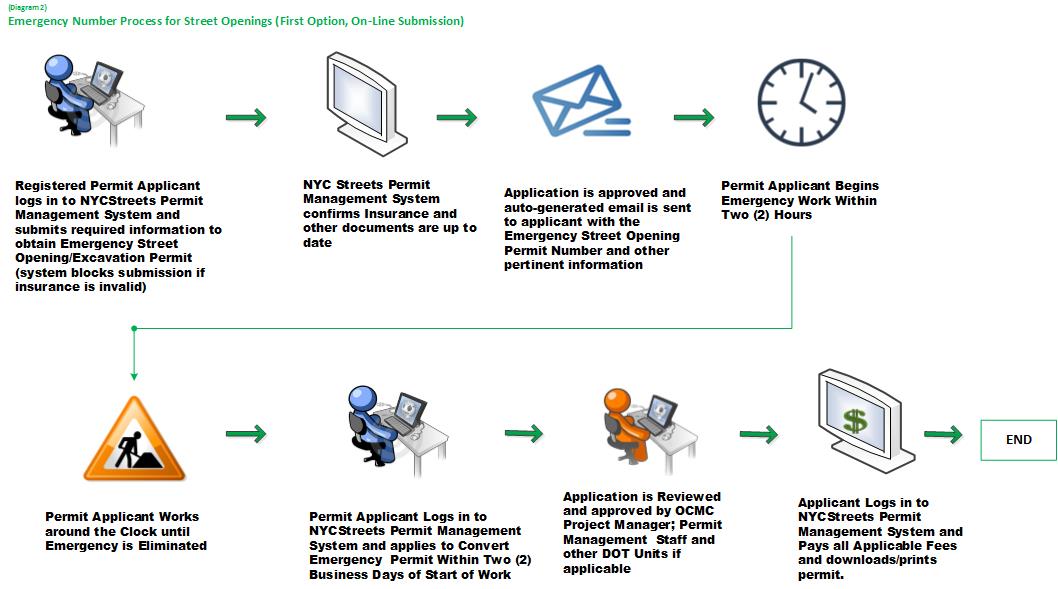3.6 Emergency Work and Special Circumstances

In addition to the application procedures for the four categories of permit types, there are some situations or street conditions that require special procedures. These include:
- Emergency utility access cover openings and emergency street openings/excavations
- Embargoes
3.6.1 Emergency Utility Access Cover Openings and Emergency Street Openings
Certain circumstances are considered to be emergencies, meaning situations that endanger the public safety or cause or are likely to cause the imminent interruption of service. Special and separate procedures govern emergency work: one for utility access covers (including those for "manholes," valve covers and grates) and one for street openings/excavations. The following procedures must be followed to obtain either an emergency authorization number (EAN) for emergency utility access cover work or an Emergency Street Opening Permit Number for emergency street opening work.
Procedures for Obtaining Authorization Numbers for Emergency Utility Access Cover Openings
Any emergency work on a street that involves opening a utility access cover to gain access to an underground facility on a critical street during restricted hours requires an EAN. NYC DOT has a separate procedure for obtaining authorization for emergency utility access cover openings so that applicants can expeditiously perform such work.
Applicants have two options to acquire an EAN. The first option (see Diagram 1) is by using the DOT on-line NYCStreets Permit Management system. Applicants who are registered as permittees (see Section 3.2) and are registered for on-line permitting can log-in to NYCStreets and request an EAN. If all information is satisfactory the applicant is approved and the system auto-generates an email which is sent to the applicant with the EAN. NYCStreets system will automatically block an applicant from submission if insurance is not current.
The second option is available for applicants who do not have the technology to use the above procedure. Applicants must first submit an Emergency Authorization Number Form. The form must be completed and faxed to NYC DOT’s Emergency Authorization Unit (EAU), which will confirm that the applicant's insurance is current and that the location requires an EAN.
If all information is satisfactory, EAU will fax or call the applicant with an EAN, which must be available at the work site and presented to any governmental employee upon request. An EAN is required for each utility access cover opening at a location, provided that the work is performed around the clock until the emergency is eliminated, at which time the EAN expires. The Highway Rules, Section 2-07(c) (4) contains additional information. The applicant will be charged a fee of $30 for each utility access cover opening EAN.

Procedures for Obtaining an Emergency Street Opening Permit
Any emergency work on a street that involves a street opening/excavation requires a Street Opening Permit. NYC DOT has a separate procedure for obtaining permits for emergency street opening/excavation work so that applicants can expeditiously obtain such permits.
Applicants have two options to acquire an emergency street opening/excavation permit. The first and most expeditious option (see Diagram 2), is by using the DOT on-line NYCStreets Permit Management system. Applicants who are registered as permitees (see Section 3.2) and are registered for on-line permitting can log-in to NYCStreets and submit a request for an emergency street opening/excavation permit. NYCStreets confirms that the applicants insurance is current; approves application and auto-generates an Emergency Street Opening permit number, which authorizes the emergency street opening/excavation work. NYCStreets system will automatically block an applicant from submission if insurance is not current.
The second option is available for applicants who do not have the technology to use the above procedure. Applicants must first submit an Emergency Street Opening Permit Form. A copy of the form can also be found in Appendix B, Forms. The form must be completed and faxed to EAU, which will confirm that the applicant's insurance is current. EAU will process the request and fax or call the applicant with an Emergency Street Opening Permit Number, which authorizes the emergency street opening/excavation work. If the insurance is not current, the request will be denied. The Emergency Street Opening Permit Number must be available at the site and presented to any governmental employee upon request. Work must begin within two hours ![]() after obtaining an Emergency Street Opening Permit Number and must be performed around the clock until the emergency is eliminated, unless otherwise directed by NYC DOT. Only one Emergency Street Opening Permit Number is required for a specific work location.
after obtaining an Emergency Street Opening Permit Number and must be performed around the clock until the emergency is eliminated, unless otherwise directed by NYC DOT. Only one Emergency Street Opening Permit Number is required for a specific work location.
Following issuance of the Emergency Street Opening Permit Number, the permittee must submit an application for a regular Street Opening Permit within two business days ![]() (Highway Rules, Section 2-11(g)). This Street Opening Permit retroactively covers the emergency street opening/excavation work already performed.
(Highway Rules, Section 2-11(g)). This Street Opening Permit retroactively covers the emergency street opening/excavation work already performed.

3.6.2 Embargoes
OCMC imposes construction embargoes* for significant special events including the New York City Marathon, parades, high profile projects and for the winter holiday season. All active permits in the affected area(s) are suspended during the dates and times of the embargo period and no new permits may be approved, unless a waiver for the work is granted by OCMC. The suspension does not apply to emergency authorizations and permits (see Section 3.6.1 Emergency Utility Access Cover Openings and Emergency Street Openings).
A list of construction embargoes under way at any given time can be found on the Construction Embargoes page on NYC DOT's website or at the borough Permit Offices.
In order to apply for an embargo waiver, a Request for Roadway/Sidewalk Permits during Embargo Periods form must be submitted for review and consideration to the Permit Office. Applicant should submit this form with the appropriate documentation and waiver request fee. Payment of the waiver request fee, as specified in the Highway Rules, Section 2-03, does not guarantee that approval to work during the embargo period will be granted. If the request is approved or modified, then all conditions, restrictions, fees and application procedures for obtaining a construction-related permit apply.
Winter holiday embargo—The winter holiday embargo typically starts in mid-November and lasts through January 2. As of August 31, 2017, a new Holiday Embargo (HE) review process has replaced the previously used HE waiver request process used by NYCSTREETS. During the application process, the NYCSTREETS system will automatically identify cases which require additional HE review, and processes them accordingly.
If a permit application includes permit requests to work on embargoed streets within 90 days prior to the start of the HE (November 16th), the permittee will be presented with a warning, during the application process, stating that such permit request(s) will be subject to the upcoming HE. If work is planned through the HE period, the critical reasons for the work must be included in the “Work Description” field of the application.
For all permit applications including permit requests to work on embargoed streets through the HE period, the permittee will be automatically charged an additional $135 HE application review fee. Details about the exact holiday embargo dates, times, and locations are posted on NYC DOT's Special Traffic Advisory page, generally in mid-October.